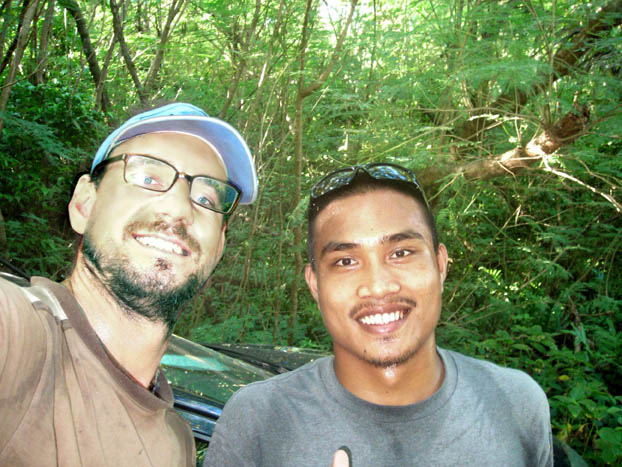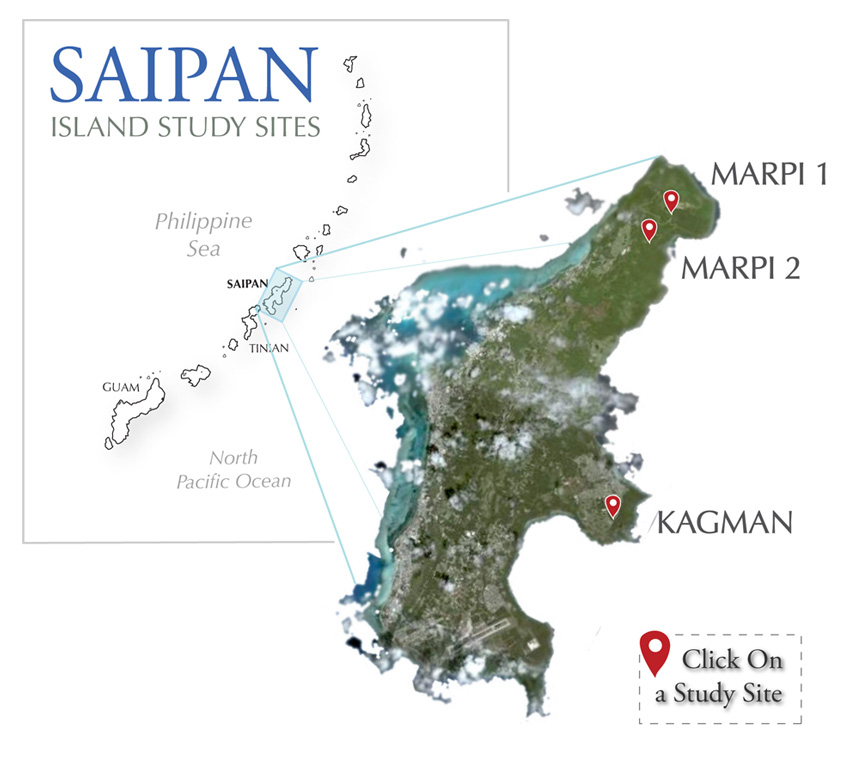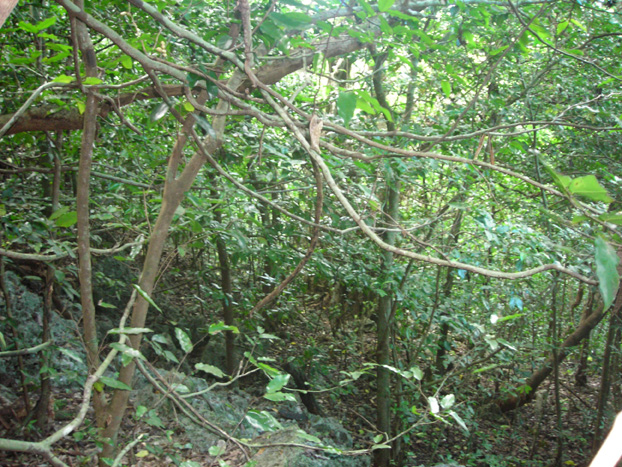The Division of Fish and Wildlife has done an excellent job of identifying and surveying conservation areas. Ideally there should be a database on the location of all species on the IUCN list for the Marianas. Within the next year, the removal of non-native vines from the Kargam fragment needs to be undertaken. Experimental removal of non-native trees should be done on a small scale in the MARPI site to identify if non-native hinder or nurture the growth on native endemic plants.


The Mariana Islands are an archipelago composed of 14 islands that cover only 472 km2 in the Philippine Sea. The largest of these islands is Saipan, which covers approximately 115 km2 and is composed of Eocene volcanic rock overlaid by limestone ranging from the Eocene to the Holocene. Saipan receives between 1866 mm and 2286 mm of annual precipitation and has a dry season caused by monsoon weather from December to June.
The Mariana Islands were first colonized 3,500 years ago by the Chamorros (Spoehr 1955). Since then, four successive foreign powers (Spain, Germany, Japan, United States of America) have successfully conquered and altered the islands ecosystems. The Spanish first colonized the islands approximately 400 years ago and introduced large-scale agriculture and non-native plants that became invasive species. The forests of the Mariana Islands were most seriously impacted during World War II, especially the largest islands Saipan and Tinian which were the center of the war-time activity. The destruction of the island’s native vegetation during this time cannot be over-estimated.

The United States Navy and Air Force fired approximately 180,000 shells on the island over a period of two days (Pratt 1948). Wartime napalm was used for the first time on Saipan, and after the war the island was reseeded from aircrafts with a non native tree (Leucaena leucocephala), which formed pure stands that choked out surviving native vegetation, especially in the lowlands.
Today, the Mariana Islands are a Commonwealth of the United States of America (Commonwealth of the Northern Mariana Islands). Remaining native forest occurs in small isolated fragments on steep slopes at low elevations and highland conservation areas (Mueller-Dombois & Fosberg, 1998). The highlands (250 m) in the northern section of the island has been set aside as a conservation area which receives funds from the United States Federal Government and mitigation funds from private businesses such as banks and developers. This large fragment covers approximately 64 hectares and is composed of a mosaic of native and non-native forest that protects rare native birds (Vogt and Williams, 2004). It is amazing that any native forest exists on the island after World War II. However, the limestone, relatively large single reserve, and a strong natural resource management program has conserved it to this day.
Study Sites: (Refer to map above.)
Three study sites were surveyed on Saipan in December 2006. Study sites included the Saipan Upland Mitigation Bank (MARPI 1, MARPI 2), and Kagman Wildlife Conservation Area.
Location: MARPI 1
MARPI 1 was located on a relatively flat limestone area at 190 m elevation with few non-native trees species. There was evidence of small Japanese bunkers at two locations along the transect site. There were a number of large Pisonia grandis trees (100 cm dbh) within the transect which is impressive because the tree must be less than 60 years old. This site had 12 native species richness and high biomass, largely due to Pisonia grandis. The conservation status of this forest is excellent.
Location: MARPI 2
MARPI 2 is located on a steep blocky limestone slope at 100 m elevation on a northeast slope of the reserve. A United States hand grenade was found in the transect. The forest contained the second highest species richness and large native trees (Erythrina variegata, Cynometra ramiflora, Guamia mariannae) and few non-native species. This site is an excellent example of healthy native forest.
Location: KAGMAN
Kargam fragment is a lowland site at 40 m elevation and 70 m from the coast. This is the largest remaining native fragment at low elevations on Saipan that covers an area of less than 3 ha. The forest has been protected by steep slopes on blocky limestone and can only be reached after a steep climb. Above the site is physical evidence of entrenched Japanese bunkers. Despite the small size of the fragment, this was the most species rich site in Saipan with 23 native species. The high species richness is due to the combination of coastal (Barringtonia asiatica, Terminalia catappa, Pandanus sp) and non-native species, however, it still had the highest species richness of native trees, shrubs, and lianas.
The region is being invaded by non-native vines that are killing native trees by shutting light to the canopy and HAS to be removed As Soon As Possible (ASAP).
Mueller-Dombois, D. and Fosberg, R. F. (1998) Vegetation of the tropical Pacific Islands. New York, NY: Springer-Verlag.
Pratt, F. (1948) The Marianas War. New York, NY: William Sloan Associates.
Spoehr, A. (1954) Saipan: The Ethnology of a War-Devastated Island. Chicago, IL: Chicago Natural History Museum.Vogt, S. and Williams, L.L. (2004). Common Flora and Fauna of the Mariana Islands. Saipan, Northern Marianas: WinGuide Saipan.
Acknowledgments
I would like to thank Nicole G. Spina and Natalie Stauffer for excellent research on the Mariana forests. Laura L. Williams from the Division of Fish & Wildlife was extremely helpful, knowledgeable, and kind. My field assistant was perfect!
Thank you to Google Earth for providing the plot images.
